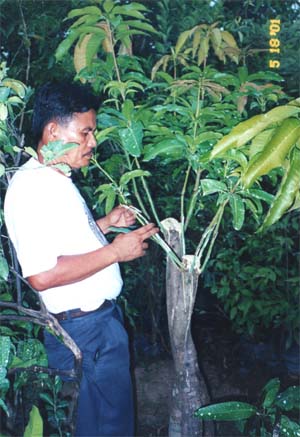|
Varietal Selections |
|
|
 |
 |
|
|
Philippine Panorama, Sunday, June
3, 2001 |
|
How to
produce better quality mango
|
|
Agri-Talk by
Zac B. Sarian
|
|
|
|
One way of
making our fruits more competitive in the world
market is to improve their quality. This means their
eating quality, keeping quality, their size to suit
what the market needs, and their appearance.
Taking mango, for instances. Of course, the carabao
mango is the pride of the Philippines and local
agricultural officials are banking on this crop as
an export winner. Of course, not all carabao mangoes
are excellent quality. Some are small-fruited with a
lot of fiber. These are the inferior varieties that
command a low price in the local market.
Fortunately, the excellent carabao mango selections
have been identified and now registered with the
National Seed Industry Council, formerly know as the
Philippine Seed Board. These include four Guimaras
mangoes (Nos. 73, 77, 84 and 85), two more Guimaras
called Talaban and Fresco, the Lamao No.1 originally
from Bataan, and the MMSU Gold from Batac, Ilocos
Norte.
|
 |
|
|
The
fruits of these registered carabao mango varieties are
usually much bigger than the inferior carabao mango. The
fruits of the Guimaras selections, for instance, average
about 300 grams each. Besides their big size, they have a
high percentage of edible portion because their seeds are
thin. They are sweet, juicy and with scanty fibers -
characteristics preferred by consumers.
 Of course planting the desired varieties is just one step toward
the production of high-quality fruits. The fruits should not
only big and fleshy, they should also look attractive. That
means they are blemish-free like most of the mangoes
produced in Cebu. The technique, of course, is wrapping the
fruits while they are on the tree. Of course planting the desired varieties is just one step toward
the production of high-quality fruits. The fruits should not
only big and fleshy, they should also look attractive. That
means they are blemish-free like most of the mangoes
produced in Cebu. The technique, of course, is wrapping the
fruits while they are on the tree.
What can be done to improve the fruits of inferior varieties? One
technique is to topwork the inferior tree. This is done by
cutting off the branches of the tree and replacing them with
stems (called scion) of the superior varieties. For example,
if you have planted the small-fruited Pahutan or the
so-called Batangas strain of carabao mango, you can cut off
the top of the tree, allow new branches to develop, and when
these are the size of the small finger, you could graft unto
them the scions from the desirable tree. When the trees is
young and has a trunk as big as the hand, you can cut the
tree about a meter above the ground. Wait for new branches
to come out and then graft them with the superior variety
when they have attained the right size. For bigger tree, you
can change the entire crown with the desirable variety.
 |
| Topworked Mango |
|
|
|
|
|

